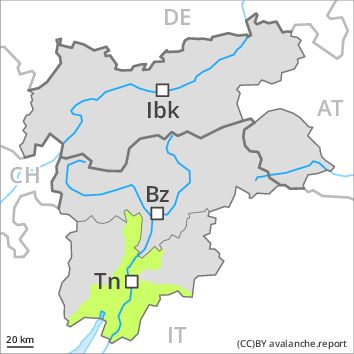Regions
Sexten Dolomites, Latemar, Southern Adamello, Sarntal Alps, Adamello - Presanella, Western Pfunderer Mountains, Northern Brenta - Peller, Southern Brenta, Southern Lagorai, Northern Lagorai, Maddalene, Pine' - Mocheni Valley, Eastern Pfunderer Mountains, Western Deferegger Alps, Ulten Valley, Eastern Nonsberger Alps, Northern Dolomites of Fiemme, Gröden Dolomites, Primiero - Pale di S. Martino, Eastern Deferegger Alps, Prags Dolomites, Schober Mountains, Lienzer Dolomites, Fassa Valley, Sole, Pejo and Rabbi

Danger level
Avalanche Problem
Wind-drifted snow above 2400m, N-NE-E-NW
Wet snow above 2400m, SE-S-SW-W-NW

The backcountry touring conditions are mostly favourable.
The rather small wind slabs have bonded quite well with the old snowpack. These can only be released by large loads in most cases. The avalanche prone locations are to be found in particular on steep northwest to north to southeast facing slopes above approximately 2400 m, especially in gullies and bowls, and behind abrupt changes in the terrain. These places are clearly recognisable to the trained eye.
In steep terrain there is a danger of falling on the icy crust. The early morning will see quite favourable conditions generally, but the danger of wet and gliding avalanches will increase later. This applies in particular on steep grassy slopes and at the base of rock walls below approximately 2400 m.
Snowpack
The fresh and somewhat older wind slabs are mostly small and can only be released in isolated cases. In some cases relatively hard layers of snow are lying on old snow containing large grains. Individual weak layers exist deep in the snowpack on shady slopes. The snowpack will be subject to considerable local variations. The surface of the snowpack will freeze to form a strong crust and will soften during the day. Below approximately 2000 m only a little snow is lying on south and southwest facing slopes.
Tendency
Slight increase in avalanche danger in the regions exposed to heavier precipitation.
